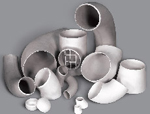Tube welding fittings
Tube Welding Fittings
Fittings are produced by extrusion and pressing. The seamless tubes form input intermediate products for their production. The welded fittings are mainly used as part of the piping systems in building and power industries.
How are pipe fittings measured ?
• Pipe fittings are measured by their diameter, wall thickness (known as
“schedule”), and shape or configuration. (Fittings are also defined by their
material grade and whether they are welded or seamless.)
• Diameter refers to outside diameter of a pipe or fitting.
• The North American standard is known as Nominal Pipe Size (NPS). The
International Standard is known as Diameter Nominal (DN). Pipes and fittings are
actually made in similar sizes around the world: they are just labeled
differently.
• From ½ in to 12 inch “Nominal Pipe Size”, outside diameters are slightly larger
than indicated size; inside diameters get smaller as schedules grow.
• From 14 in and larger “Nominal Pipe Size”, outside diameters are exactly as
indicated size; inside diameters get smaller as schedules grow.
• As with other North American standards (inch, foot, yard, mile, …), many pipe
standards (diameters up to 12 inch and wall thickness) are based on historical
precedents (a toolmaker’s dies during US Civil War) rather than a “scientific”
method.
What is a seamless butt weld fitting ?
• A seamless butt weld pipe fitting is made directly from a section of seamless pipe material, by applying heat and pressure to transform pipe directly into an elbow or other shape.
• A seamless fitting has no welded parts by itself, a characteristic demanded in some critical applications.
• By comparison, a regular butt weld fitting has one, two or more welds, depending on dimension, shape and manufacturing method.
• No weld means less risk of weld yield and passage.
What is a butt weld pipe fitting ?
• A butt weld pipe fitting is designed to be welded on site at its end(s) to connect pipe(s) together and allow change in direction or pipe diameter, or branching or ending.
• This fitting then becomes part of a system for transporting fluids (oil, gas, steam, chemi cals, …) in a safe and efficient manner, over short or long distances.
cals, …) in a safe and efficient manner, over short or long distances.
• Other types of fittings can be threaded or socket welded

